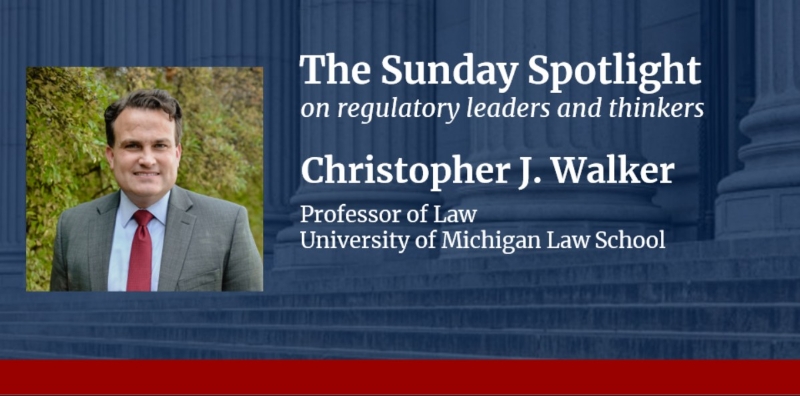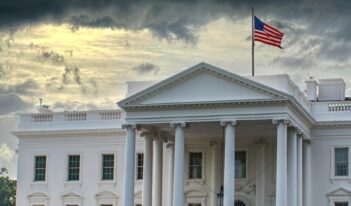
Christopher J. Walker discusses how developments in administrative law doctrines could constrain agency action.
In a conversation with The Regulatory Review, administrative law scholar Christopher Walker discusses how changes in administrative law doctrine could alter the balance of power between federal courts, the U.S. Congress, and regulatory agencies.
At a time when agency action is increasingly scrutinized, Walker offers valuable insights into the U.S. Supreme Court’s administrative law jurisprudence. Commenting on the Court’s recent decisions, Walker explains how the Court has taken what is sometimes described as an “anti-administrativist turn”—an analytical lens through which the Court “has myopically focused on constraining agency action.”
Walker also reflects on how administrative law doctrine will continue to take shape during the second Trump Administration. He comments on the rise of initiatives such as the Department of Government Efficiency (DOGE), examining how the new Administration could leverage the power of judicial precedents to advance a deregulatory agenda.
Walker is a professor of law at the University of Michigan Law School, where he focuses his scholarship on administrative law, regulation, and agency-level policymaking. Walker’s teaching and scholarship are informed by his experiences working in private practice and all three branches of the federal government.
Beyond Michigan Law, Walker serves as a senior fellow of the Administrative Conference of the United States and as the section editor for the Administrative Law Section of Jotwell. He previously chaired the American Bar Association’s Section of Administrative Law and Regulatory Practice. Walker is also a frequent contributor to the Yale Journal on Regulation. In 2022, the Federalist Society awarded him the Joseph Story Award, recognizing his leadership as a scholar and professor.
The Regulatory Review is pleased to share the following interview with Christopher Walker.
The Regulatory Review: What is the role of federal courts in constraining agency action?
Walker: The U.S. Supreme Court has made a number of major moves in recent years to rein in administrative and presidential power—whether that’s through the new major questions doctrine, the elimination of Chevron deference, a harder look review of changes in agency policymaking, or the narrowing of agency adjudication when it comes to civil penalties. A nondelegation doctrine revival may also be on the horizon.
One problem with this “anti-administrativist” turn is that the Supreme Court has myopically focused on constraining agency action. And yet, to serve as faithful agents of Congress, agencies must also be empowered to fulfill their statutory mandates. These judicial developments do little to encourage agencies to act. Indeed, if a court misapplies these doctrines, it ends up prohibiting an agency from fulfilling its statutory obligations. That leads to a second problem: The Court’s vision for the administrative state assumes a higher-functioning Congress—one that currently does not exist.
TRR: Is the U.S. Congress positioned to respond to the anti-administrativist turn in the federal judiciary?
Walker: As I’ve explored in a recent article, Congress has a powerful set of tools to reassert itself in the separation-of-powers framework. Congress could better leverage its oversight, personnel, and appropriations powers to share in administrative policymaking. It could, for example, creatively implement legislative fast-track procedures to respond to judicial decisions and reinvigorate its reauthorization processes to update statutes to respond to changed circumstances, including changes imposed by courts. Back in 2020, we debated reauthorization here in The Regulatory Review. That debate should be revisited in light of these recent judicial developments in administrative law.
TRR: How might the Supreme Court’s recent decision Loper Bright Enterprises v. Raimondo affect the current constraints on the administrative state?
Walker: If you asked a dozen administrative law scholars this question, you’d be surprised about the wide range of opinions. Some scholars view Loper Bright’s elimination of Chevron deference as the end of the administrative state as we know it, with courts now playing the central role in administrative policymaking. Some scholars view judicially imposed constraints on agency action as a good thing, and other scholars see it as the worst possible outcome. By contrast, scholars such as Adrian Vermeule and Kristin Hickman view Loper Bright as not making much of a change to how courts review agency actions. In their view, judicial deference is inevitable in the modern administrative state.
My view is somewhere in the middle. A decade or so ago, Kent Barnett and I read every federal court of appeals decision that implicated Chevron deference from 2003 through 2013—representing more than 1,500 court-reviewed agency statutory interpretations. We found that Chevron deference seemed to matter quite a bit in the lower courts. In our dataset, there was nearly a 25 percentage-point difference in agency-win rates when the courts of appeals applied Chevron deference than when they did not. When courts found statutes ambiguous and reached the second step of the Chevron inquiry, they upheld agencies’ statutory interpretations 95 percent of the time.
In subsequent work with Christy Boyd, we found in our dataset that Chevron deference seemed to lead to greater national uniformity in federal law and less partisanship in judicial decisionmaking. In other words, Chevron deference seemed to place a heavy thumb on the scale for federal agencies, which I have argued was largely a good thing.
But that was back in 2013. Over the last decade, we have seen a rising anti-administrativist mood in the federal courts. The first Trump Administration both appointed federal judges who were more skeptical of Chevron and other deference doctrines and generally declined to ask for judicial deference when defending federal agency actions in court. In other words, Chevron has been dying for more than a decade, so I don’t anticipate Loper Bright having much of an impact on how courts and agencies currently approach their respective roles. If Loper Bright had been decided a decade ago, however, the immediate impact would have been much more profound.
TRR: What about the Court’s recent decision in Corner Post v. Board of Governors of the Federal Reserve System?
Walker: In Corner Post, the Supreme Court held that an Administrative Procedure Act claim does not accrue under the default six-year statute of limitations statute until the plaintiff is actually injured. In other words, a company created in 2024 could challenge a rule issued decades before. That holding cuts against the previously conventional view in administrative law that a claim accrues when a rule is issued, and a subsequent birth or corporate creation does not restart the clock.
Combined with the elimination of Chevron deference and the emergence of the new major questions doctrine, one could imagine Corner Post opening up the entire modern administrative state to judicial reexamination. But that’s an exaggeration. For example, the six-year statute of limitations is merely the default provision. In many statutes, Congress has codified a distinct statute of limitations or statute of repose, which is a statute that requires a claim to be filed within a certain time after an agency’s actions even if no one has yet been injured. It remains to be seen how much litigants will be able to use Corner Post to challenge older regulations.
TRR: You previously commented on the Court’s decision in Kisor v. Wilkie, where the Court addressed whether courts must defer to an agency’s interpretation of its own regulations. What might Loper Bright Enterprises v. Raimondo mean for other forms of judicial deference that courts have afforded to agency interpretations?
Walker: After Loper Bright, it’s hard to imagine other administrative law deference doctrines surviving. To be sure, the Loper Bright Court suggested that Skidmore deference still plays a role when courts review judicial interpretations. In a recent immigration case in the U.S. Court of Appeals for the Ninth Circuit, Michael Kagan and I filed an amicus brief explaining how we see Skidmore interacting with Loper Bright’s command that courts exercise “independent judgment.”
But the obvious next target is Auer deference to agency interpretations of their won regulations. As you note, in 2019 the Court refused to overrule Auer v. Robbins in Kisor v. Wilkie. But that was five years ago, and since then Justices Kavanaugh and Barrett have replaced Justices Breyer and Ginsburg on the Court. My guess is that it’s only a matter of time until the Court revisits and overrules Auer deference.
TRR: How will the second Trump Administration leverage these judicial precedents?
Walker: The headline-grabbing administrative law development of the second Trump Administration to date has to be his creation of DOGE , which is a governmental organization run by Elon Musk that will advise President Trump on how to make the administrative state leaner and more efficient.
Musk and DOGE’s former co-leader, Vivek Ramaswamy, view these judicial precedents as helpful in DOGE’s efforts. As Ramaswamy explained on X, “The overturning of Chevron deference, combined with the Major Questions Doctrine enshrined in West Virginia vs. EPA, paves the way for not slight but *drastic* downsizing in the scope of the federal regulatory state.” My colleague Nick Bagley disagrees and has argued that Loper Bright will make it harder for deregulation and other changes in administrative policy.
Just as DOGE proponents probably overestimate the power of these precedents in a DOGE project, I think Professor Bagley underestimates them. So many regulations have been based on readings of statutes that are not the “best” interpretation of those statutes. With the help of agencies and outside groups, DOGE could identify such agency regulations and outline why they are not the best interpretation.
The Administration then has two main avenues for rescinding such regulations. First, the Administration could ask an agency to begin notice-and-comment rulemaking to rescind a regulation based on the grounds that it is not the best interpretation of the statute. That would require agency competence and resources. Second, DOGE could identify the regulation publicly, inviting those affected by the regulation to challenge it in court. And then the Administration, as Richard Pierce has explained, would choose not to defend it, letting the regulation “die a natural death in court.”
It’s too early to tell what impact DOGE will have on the administrative state, much less whether DOGE will effectively leverage these judicial developments in their deregulatory project. But this is one area I’ll be watching closely in the coming months.
TRR: How will these developments shape your approach to teaching administrative law moving forward?
Walker: Administrative law is always so much fun to teach, and even more so when there is a change in presidential administration. The class has always been well-positioned to accommodate those changes. That said, the Supreme Court’s recent changes to administrative law will reshape to some degree how we teach the subject. Kristin Hickman, Richard Pierce, and I are already working away on the next edition of our administrative law casebook. This edition will involve cutting nearly 100 pages on Chevron deference and incorporating the major questions doctrine and Loper Bright. We will also likely add a new chapter on administrative remedies—to better teach the ordinary remand rule, remand without vacatur, and the debate on universal vacatur and nationwide injunctions.
By the time the new casebook edition hits the press, we will no doubt have even more changes to administrative law—from both the courts and the second Trump Administration.



